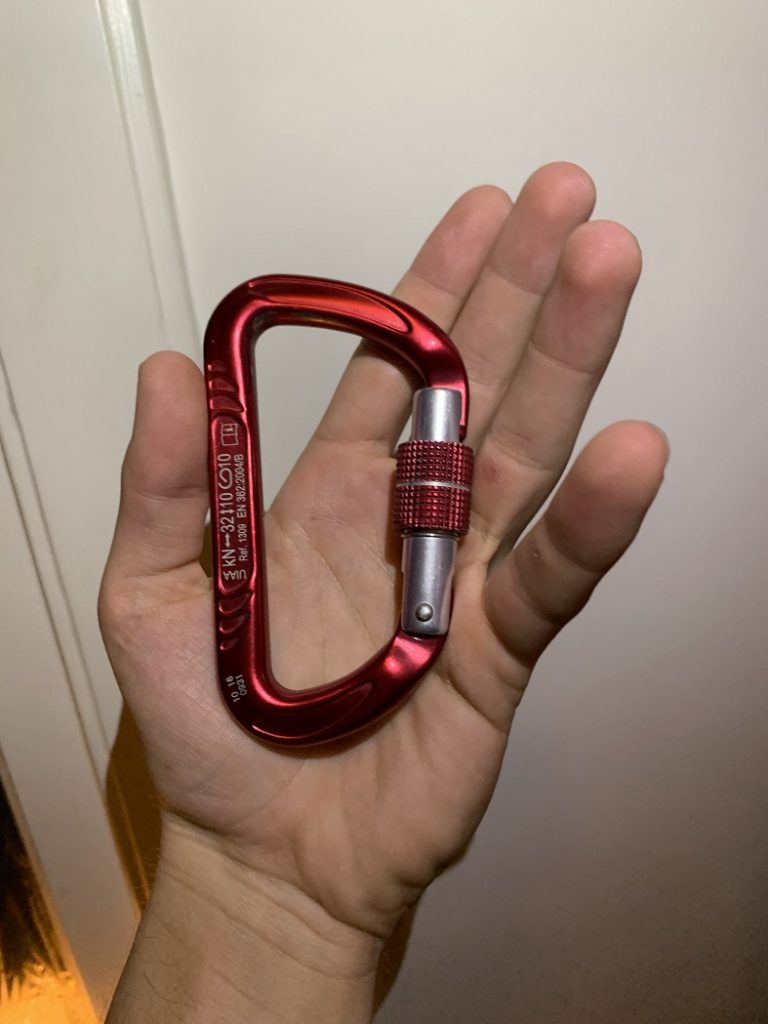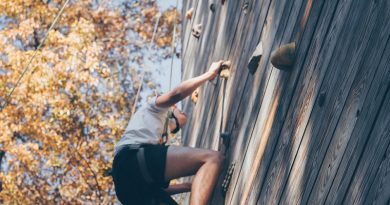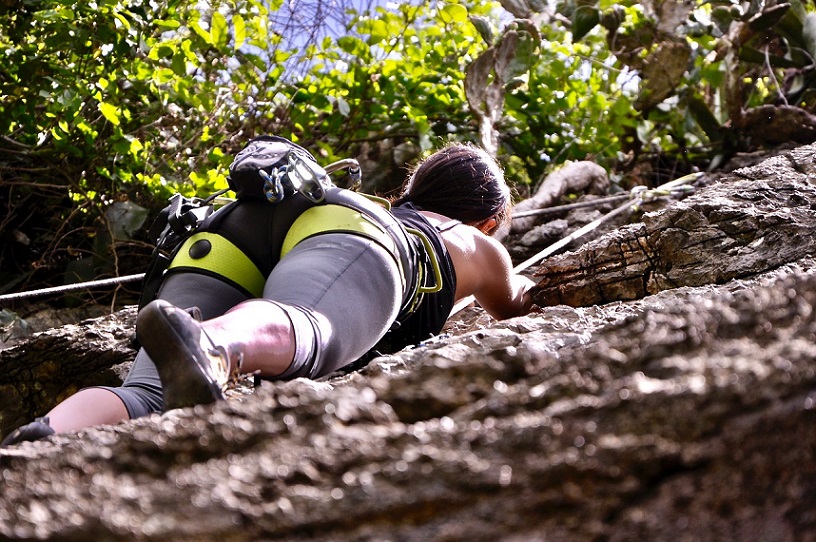The carabiner might be one of the smallest pieces of equipment necessary for rock climbing, but that doesn’t make it any less important.
This pint-sized gear is critical to safely bearing weight while rock climbing.
But what is a carabiner, and how do different types of carabiners differ from one another?
If you’re new to rock climbing, finding the right carabiner can feel like searching for a needle in a haystack. With so many options to choose from, it can be difficult knowing which one is best-suited to meet your needs.
That’s why I’ve put together this guide below. With this information, you’ll be able to confidently select the carabiner that’s right for your rock climbing needs.
In order to do so, I’ll break down the defining aspects that separate different carabiners apart from one another before walking through their different uses.

What Is a Carabiner?
First, let’s define what a carabiner is and its important role in rock climbing.
Basically, a carabiner is a small gated piece of metal that allows for proper load bearing while climbing.
Carabiners attach ropes to your equipment or different parts of equipment together for safer, more secure holds.
In fact, carabiners have one of the most diverse roles in all of rock climbing. From attaching ropes to small gear to helping secure one to the belaying device, carabiners have their work cut out for them.
It’s for this reason that choosing the right carabiner is so important. It’s always in your best interest to choose a carabiner that’s sturdy and strong so that it can hold up to all the different challenges of the climb.
And because—quite literally—your life may depend on it.
So what makes a good carabiner, and how do you know which one is right for you?
Join me as I walk you through all the different things you should know about carabiners below.
1. Shape of your carabiner
When you go shopping for your carabiner, the first thing you’ll probably notice is that they don’t all have the same shape.
Though all feature some type of metal spine and a gate, there are different shapes available.
And trust me: these different shapes matter.
It’s true that some people prefer to use a certain shape no matter what. It’s likely that they started using one type of carabiner and got hooked (no pun intended) on it.
But the truth of the matter is that certain carabiner shapes make them better suited to different jobs.
The first thing you should know about carabiner shape is that there are three main types: D-shaped, oval, and a-symmetrical D-shaped.
Let’s look at each in turn so that you can find the carabiner that will work best for your situation.
D-Shaped
For many, D-shaped carabiners are the gold standard when looking for long-lasting durability.
D-shaped carabiners have a symmetrical design that can help balance the weight of any load. They’re also extremely solid.
In fact, in terms of pure strength alone, D-Shaped carabiners take the cake.
These extremely-strong pieces of equipment have what it takes to bear incredible loads to help you climb safely.
This does come with a drawback, however, as they are heavier than other types of carabiners. For those who are looking for a lightweight climb, D-shaped carabiners may not be the right investment.
If you’re looking for something dependable and sturdy, however, they just might be perfect for you.
Oval
The grandfather of all carabiner types, oval-shaped carabiners are the original model.
Surprisingly, despite innovations in carabiner technology, the oval-shaped variety has stood the test of time.
Some climbers prefer oval-shaped carabiners because of their symmetrical design that prevents load shifting. This is important as you climb, as it can help keep your gear in place.
It’s also worth noting that oval-shaped carabiners are extremely versatile and can be used for carabiner-brake rappels.
Despite this, they do have their own shortcomings.
Namely, their design makes them less-solid and reliable in terms of strength. If you’re looking for a heavy-duty carabiner, this one may not be for you.
That being said, oval-shaped carabiners can get any routine job done, and because of their versatility, are a great tool to take along with you for any climb.
A-Symmetrical D-Shaped
If you’ve looked into carabiner shopping, chances are that you’ve predominantly come across the a-symmetrical D-shaped variety.
These popular carabiners have come to dominate the market.
An extremely durable option, a-symmetrical D-shaped carabiners are designed with a larger gate for easier clipping and disproportionately-sized ends to reduce weight.
In this way, a-symmetrical d-shaped carabiners are a great lightweight option that still boasts great strength. Even better, because it’s so easy to climb, these are great for beginners or for those who just want the maximum in clipping convenience.
2. Size
Carabiner size is another important factor to consider, and again, the perfect one for you will likely depend on what type of climbing you plan to do.
Generally speaking, larger carabiners have more room to hold your gear. They also feature larger gates, making clipping easier and more convenient.
As you may have guessed, there drawback comes in that they’re heavier than smaller carabiners, making them undesirable for some.
Smaller carabiners, on the other hand, are more lightweight but have smaller gates. This makes them harder to use, especially for beginners. It’s also worth mentioning that they can’t hold as much gear because of their smaller size.
Additionally, make sure that your carabiner has enough gate open clearance. Primarily, this refers to the width and depth to which the gate can open. It’s also important to consider the size of the carabiner below the gate.
Having the right gate open clearance can make clipping easier and prevent accidents.
3. The Carabiner’s Weight
The weight of your rock climbing gear is important.
Carabiners are no exception.
Those looking to perform more long-range or difficult climbs generally opt for more lightweight equipment—and that’s also true here.
While this may be the general rule of thumb, let’s take a moment to discuss the issue in more detail.
All too often, it’s easy to assume that since you want a lightweight carabiner that you should get the smallest and the lightest possible.
I want to put an end to this misconception by noting that this is only true for some.
All climbers need to be aware that when they select lightweight carabiners, they’re making a tradeoff in other areas.
Now, first, I want to say that I’m not saying there’s anything wrong with that—as long as you understand what you’re doing.
But it’s important to make sure that you’re selecting your carabiner with all the information you need in order to have a climbing experience that’s safe and fun for you.
With that in mind, do make note that when you choose a very small-sized carabiner, you’re trading off in just how easy it is to clip and in how much gear it can hold.
The second issue might not be so pressing, as you likely don’t want a lot of gear if you’re looking to reduce weight anyway.
The first, however, is something to take note of. If you’re a bit more inexperienced, trying to clip these smaller carabiners can be a headache, and you need to make sure you do it correctly for your safety.
Additionally, these lightweight carabiners aren’t as durable or strong as heavier options, so make sure that you’re not overloading them with heavy equipment.
4. Load
When selecting your carabiner, make sure that you’re choosing one that is appropriate for the load you are climbing with.
If you’ve got a lot of equipment or a comparatively-heavy load, it’s probably best that you don’t use lightweight varieties.
By choosing the right carabiner for your load, you can prevent safety and other more minor issues.
For instance, it’s important to consider that your load may shift while climbing with a-symmetrical shapes. By having a full understanding of this, you’ll be able to enjoy better climbs by having more control over your load.
5. How to Choose Between Locking/Non-Locking Carabiners
One of the more important considerations you’ll have to make when choosing your carabiner is to get a locking or non-locking option.
Let’s look at each in turn.
Locking Carabiners
When it comes to locking carabiners, you actually have two options. The first is the manual screw lock, and the other is an auto-locking option.
As technology has progressed, many prefer to use the auto-locking option, as it will lock as soon as you close your carabiner.
Others, however, prefer the added peace of mind gained from manually screwing in their lock on their carabiner.
Either way, with this option, you can be sure that your load is securely fastened.
There are times when locking carabiners are your only choice. When connecting to the belaying device, for instance, it’s against standard practice to use a non-locking carabiner.
A general rule of thumb is to also use locking carabiners anywhere else you feel as if you need added security.
And, yes, while it’s true that these locking carabiners literally weigh more, they can take a larger figurative weight off your shoulders.
Make sure that you’re climbing with the right peace of mind by using locking carabiners for extra protection.
Non-Locking Carabiners
Your other option when choosing a carabiner is the non-locking variety.
Unlike locking options, there’s no way that you can lock these for better security. These carabiners are more lightweight, so they may be your preferred option for situations in which you’re securing something of not much consequence.
Make sure, however, that you’re not using them for anything too important. Because they can’t lock, they are unable to provide the security and protection you need for items of value.
And remember, never use a non-locking carabiner to attach to the belaying device. I’ve said it before, but it’s worth mentioning again, as this is one of the most important carabiner lessons you can ever learn. In fact, make sure it’s the one thing you take away from this post even if you can’t remember anything else. Making sure that you’re using your carabiners appropriately can help save your life in this instance.
6. Price
There’s a lot of variety in cost when it comes to carabiners.
As in most situations, you can expect higher-quality carabiners to cost more—but you should try to invest in them anyway.
It’s worth the few extra dollars to make sure that you’ve got safe equipment.
In general, you can expect to pay more for sturdier, D-shaped carabiners—both symmetrical and a-symmetrical—as well as those that lock.
There are several different carabiner brands available, and you may find that the price differs among each.
As you make your carabiner choice, be sure to strike a solid balance between quality and cost. And if you have to sacrifice one of them, make sure it’s the money.
7. Situation in Which You’ll Use It
Finally, when buying your carabiner, keep all this information in mind so that you can make the most informed choice possible.
Make sure that you’re choosing a carabiner that fits your rock climbing needs.
If you’re going alpine climbing, for instance, you’re likely going to want to invest in more lightweight models.
For other forms of climbing, however, you may want heavier and sturdier equipment.
By keeping the above information in mind, you should have no problem in choosing the carabiner that’s right for you.
Because it depends so much on your personal situation and what type of climbing you’re doing, it’s impossible to suggest just one type of carabiner to you.
Instead, I strongly recommend that you take the time to really assess the details of your next climbing trip so that you can purchase the right carabiner accordingly.
And as you do, remember that quality is the most important. Make sure that you’re buying from reputable brands so that you can enjoy a safe climb.
With these tips in mind, I’m sure you’ll know how to choose the carabiner right for you.






